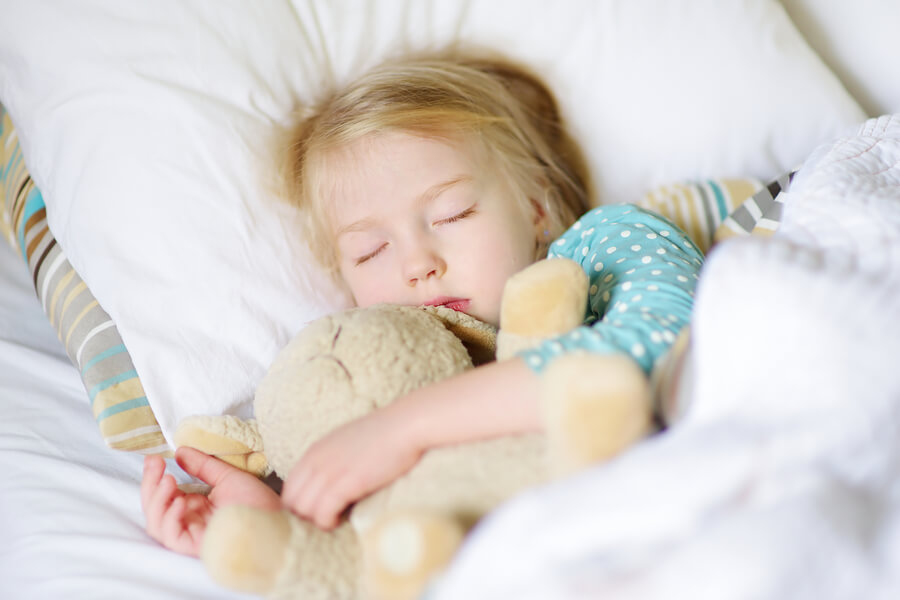Benefits of Napping for Babies and Children

Children usually nap until they’re four or five years old. The frequency and duration will depend on each child. The important thing is to know that the benefits of napping go far beyond a simple rest for the body.
Sleep is important for children’s health. It’s a fundamental factor in the physical, intellectual and emotional development of human beings.
During the hours that children sleep, not only do their bodies rest, but their brains carry out very valuable neuropsychological processes.
Given the benefits of napping for babies and children, these periods of daytime sleep should be considered very helpful. Allowing children to get enough sleep and rest will favor overall health and development.
What Are the Benefits of Napping for Children?
It’s common for parents to notice that their children are in a better mood throughout the rest of the day if they take a nap. The contrast is especially noticeable on days when they don’t take a nap. In those cases it’s common to hear parents say: “They’re irritable because they didn’t take a nap.”
What are the benefits of napping for babies and children?
- While napping, children regain physical energy. Their bodies rest and recover the mental energy they need for the rest of the day.
- Releases tension. The mind is disconnected from all external stimuli. This way, hyperactivity and anxiety are reduced.
- Napping improves attention, concentration and willingness to discover and explore the world.
- Memory improves. Children remember what they learn better if they nap. While dreaming, you record what you’ve learned during the day and you’re also more willing to learn new things.

Influence of Napping on the Child’s Life
- Naps contribute to being in a good mood and having a positive attitude. After napping, children are more relaxed. They’re also more willing to do anything that is asked of them.
- Napping contributes to normal growth. Sleep regulates certain vital functions. During sleep, the growth hormone is released, which is essential for development.
- Napping favors a good night’s rest. If children are exhausted or overexcited at night, they may have difficulty sleeping. A proper nap will allow them to have a restful night’s sleep.
- Social relations are better. A child who doesn’t take a nap may be more aggressive. Not napping can affect his emotional development and the way he interacts with other children.
“During the hours that children sleep, not only do their bodies rest, but their brains carry out very valuable neuropsychological processes.”
Duration of Naps for Children
As they grow, children need less sleep. Until four or five years old, these hours are distributed between their night sleep and nap time. Later, the daytime rest usually disappears.
- Newborns: The total amount of sleep is around 18 hours. The time that newborns nap is usually equivalent to the time that adults are awake. Naps add up to eight or nine hours.
- One month old: The total sleep time here is 17 hours. At this age, the nighttime sleep time extends – ten hours at night – and the daytime decreases – naps add up to eight hours.
- Three months old: At this stage, the total sleep time drops to 16 hours. At night, they sleep about ten hours. During the day they’ll need at least three naps, approximately two hours each.

From Six Months Old
- Six months: At the half year mark, the total sleep time is around 15 hours. Generally, babies are more stimulated externally and the naps are reduced to two. They nap for four or five hours in total.
- One year: At one year, the total sleep time will be 14 hours. Naps will be shorter. The child will take two naps of an hour and a half each.
- At 18 months, they’ll acquire the rhythm that they’ll maintain until four or five years old. The total sleep time will be 13 or 14 hours. They’ll take just one 2-hour nap.
These data are estimates. Each child will have his or her own rhythm of nocturnal sleep and naps. The important thing is to allow for and encourage those moments of rest.
Eliminating naps for the convenience of parents or for work reasons is not a good idea. This habit can harm the child’s normal development, so it’s best to promote nap time.
All cited sources were thoroughly reviewed by our team to ensure their quality, reliability, currency, and validity. The bibliography of this article was considered reliable and of academic or scientific accuracy.
- Azlan Ahmad Kamal et al. / Perceptions on taking a Daily Nap for a Better Quality of Life among Physical & Health Education students in Malaysia. Procedia – Social and Behavioral Sciences 35 ( 2012 ) 162 – 169.
- Weir, K. The science of naps. American Psychology Association. 2016, Vol 47, Nº 7, 48. [Online] Avaiable at: https://www.apa.org/monitor/2016/07-08/naps
This text is provided for informational purposes only and does not replace consultation with a professional. If in doubt, consult your specialist.
